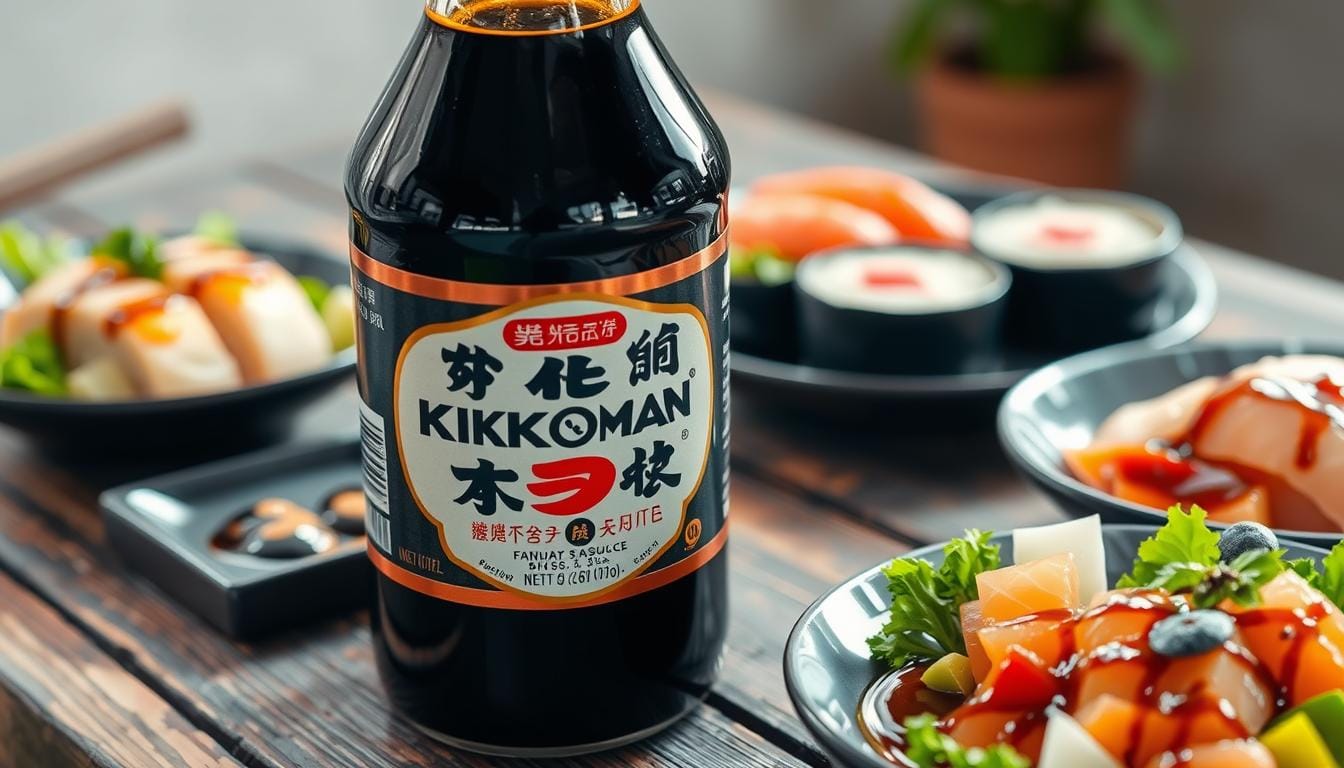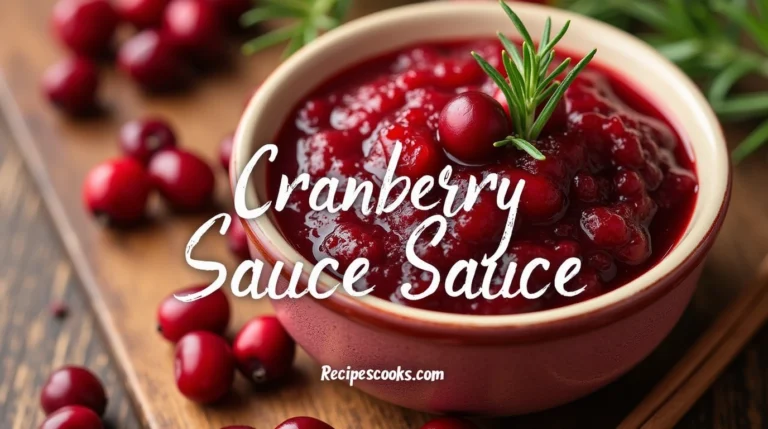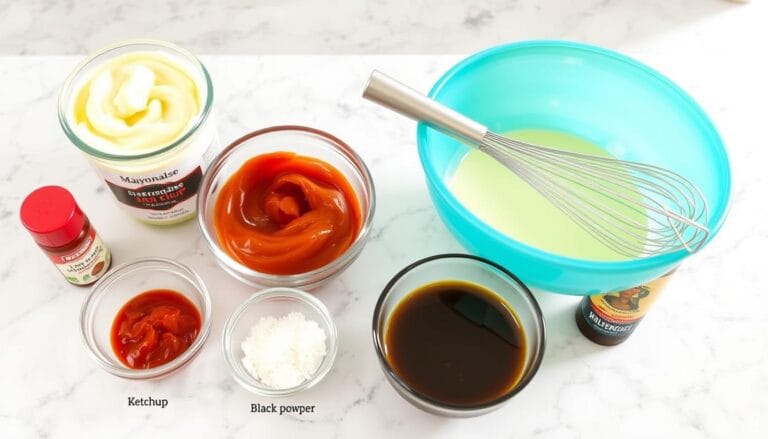The Authentic Kikkoman Soy Sauce
Do you remember the last time a savory dish filled your kitchen with a delicious smell? It was probably because of the authentic soy sauce that made it special. For many, Kikkoman soy sauce is more than a condiment. It’s a partner that makes ordinary meals extraordinary.
Kikkoman soy sauce is a big name, holding 30% of the global soy sauce market. This shows how much people love and trust it. With over 110 years of tradition, Kikkoman offers not just the best soy sauce but also a taste of Japanese culture.
Their brewing process takes a whole year, using natural climate conditions for fermentation. This creates complex and authentic flavors. People love the balance of sweetness, saltiness, and slight acidity, making it a favorite in kitchens everywhere.
Exploring Kikkoman soy sauce opens up a world of possibilities. It makes dishes better, pleasing your taste buds and creating memories. Try it in ginger orange chicken wings or Hawaiian fried rice to see what you can make.
Table of Contents
Introduction to Soy Sauce
Soy sauce is a key ingredient in kitchens worldwide, loved for its savory umami flavor. It has a long history, starting in ancient China over two thousand years ago. Over time, it evolved into the rich, complex condiment we know today.
The journey of soy sauce includes big changes, especially with Japanese soy sauce. This type of soy sauce has its own unique taste, shaped by local ingredients and methods.
The history of soy sauce shows a mix of cultural influences and culinary creativity. It began as a food preservative but has grown into a key flavor enhancer. In the West, it’s used in many dishes, thanks to its versatility.
In Japan, traditional techniques were adopted and adapted, leading to different soy sauce styles. These styles are known for their distinct flavors.
Today, making soy sauce is a careful art that continues to grow. The main ingredients are soybeans, wheat, salt, and water. These are mixed and fermented to create the desired taste and aroma.
Kikkoman, a leading soy sauce maker, has a history dating back to 1603. Their work shows the importance of soy sauce in cooking traditions. They distribute their soy sauce in over 100 countries.
Exploring soy sauce’s flavors reveals its journey from ancient times to today. Knowing its history makes us appreciate this timeless condiment more. It reminds us of its cultural roots and its role in modern cooking.
What Makes Kikkoman Soy Sauce Stand Out?
Kikkoman soy sauce is known as one of the top soy sauces. It’s made with a special mix of soybeans and wheat. This gives it a thinner texture and a salty taste that goes well with many foods. Chefs and home cooks love it for its ability to enhance dishes.
The soy sauce’s fermentation process takes 3 to 6 months. This long time lets the flavors mature, creating a deep taste. It’s made from just water, soybeans, wheat, and salt. This simplicity makes it stand out from other brands.
Kikkoman uses big tanks to make their soy sauce, from 15,000 to 100,000 gallons. They’ve been making soy sauce for over 350 years. Today, they’re the biggest soy sauce brand worldwide, with most sales coming from outside Japan.
Kikkoman also offers gluten-free tamari and gluten-free soy sauce. This lets people with dietary restrictions enjoy their soy sauce flavors. This flexibility makes Kikkoman a top choice in the soy sauce market.
| Feature | Kikkoman Soy Sauce | Tamari |
|---|---|---|
| Base Ingredients | Soybeans, Wheat, Salt, Water | Higher concentration of Soybeans, usually less Wheat |
| Flavor Profile | Salty, Thinner consistency | Richer flavor, Thicker viscosity |
| Recommended Uses | Wide applications including marinades and stir-fries | Best for dressings, dipping sauces, seafood |
| Fermentation Time | 3 to 6 months | Varies, typically similar |
The Brewing Process of Kikkoman Soy Sauce
The brewing of Kikkoman soy sauce turns simple ingredients into a flavorful condiment loved worldwide. This detailed method mixes different elements to create the unique taste of Kikkoman soy sauce.
The Ingredients That Define Flavor
The heart of Kikkoman soy sauce is its basic ingredients:
- Steamed soybeans
- Roasted wheat
- Koji mold
Each ingredient is key to the final flavor. Steamed soybeans give a deep umami taste. Roasted wheat adds sweetness and depth. The koji mold starts the fermentation, crucial for the sauce’s complex flavors.
The Role of Fermentation in Flavor Development
Fermentation is vital in making soy sauce. Kikkoman uses a traditional method that lasts several months, often over six months. This time lets the ingredients blend and create strong flavors.
The fermentation vats, made from cedar wood, also add to the flavor. This natural wood brings subtle notes that improve the soy sauce’s taste. As it ferments, sugars and amino acids break down, giving Kikkoman soy sauce its distinct rich taste.
| Ingredient | Function |
|---|---|
| Steamed Soybeans | Provides a rich umami flavor |
| Roasted Wheat | Adds sweetness and depth |
| Koji Mold | Initiates fermentation process |
This detailed brewing process, along with high-quality ingredients, makes Kikkoman a favorite among chefs and food lovers.
Exploring Different Types of Kikkoman Soy Sauce
Kikkoman has a wide range of soy sauces for different tastes and needs. Two popular choices are low sodium soy sauce and gluten-free soy sauce. Each type is perfect for certain dishes, keeping the rich flavor of Kikkoman soy sauce.
Low Sodium Soy Sauce
Kikkoman’s low sodium soy sauce is great for those watching their salt intake. It has less sodium than regular soy sauces but still packs a lot of flavor. It’s perfect for marinades, stir-fries, and sauces, making your meals tasty and healthy.
Gluten-Free Soy Sauce
Kikkoman’s gluten-free soy sauce is ideal for those with gluten sensitivities or celiac disease. It’s made without wheat but still has the classic Kikkoman taste. It’s great for Asian dishes, dressings, and as a seasoning, letting you enjoy your food without worrying about gluten.
How to Use Kikkoman Soy Sauce in Cooking
Kikkoman soy sauce brings a rich flavor to many dishes. It can make your meals better by adding it in different ways. Here are some ideas to get you started:
- Marinating meats: Mix Kikkoman soy sauce with garlic, ginger, and spices for a tasty marinade. Let your meats soak for at least 30 minutes to soak up the flavor.
- Enhancing soups: Add a bit of soy sauce to your soups for a deeper taste. It’s great with broths and stews, making them savory.
- Salad dressings: Blend Kikkoman soy sauce with vinegar and olive oil for a tasty dressing. It gives your salads a unique flavor.
- Stir-fries: Soy sauce is perfect for stir-fries with veggies and proteins. Add fresh ingredients for a complete meal.
When cooking with soy sauce, balance is important. Try adding a bit of sweetness, like honey or sugar, to balance out the saltiness. This makes your dishes taste better.
Looking for new ideas? Kikkoman has many tasty recipes that use their soy sauce. You can find recipes for tofu, seafood, and veggies. Trying these can help you learn new cooking skills and add exciting flavors to your meals.
The Health Benefits of Kikkoman Soy Sauce
Kikkoman soy sauce is not just tasty; it’s also good for you. It adds flavor to your meals and supports your health goals. If you’re interested in its nutritional value or want to cut down on salt, this info is for you.
Reduced Sodium Options for a Healthier Diet
For those watching their salt intake, reduced sodium soy sauce is a great choice. Regular soy sauce has about 878 milligrams of sodium per tablespoon. That’s almost 40% of the daily sodium limit. Kikkoman’s reduced sodium version has much less salt, making it perfect for those counting sodium.
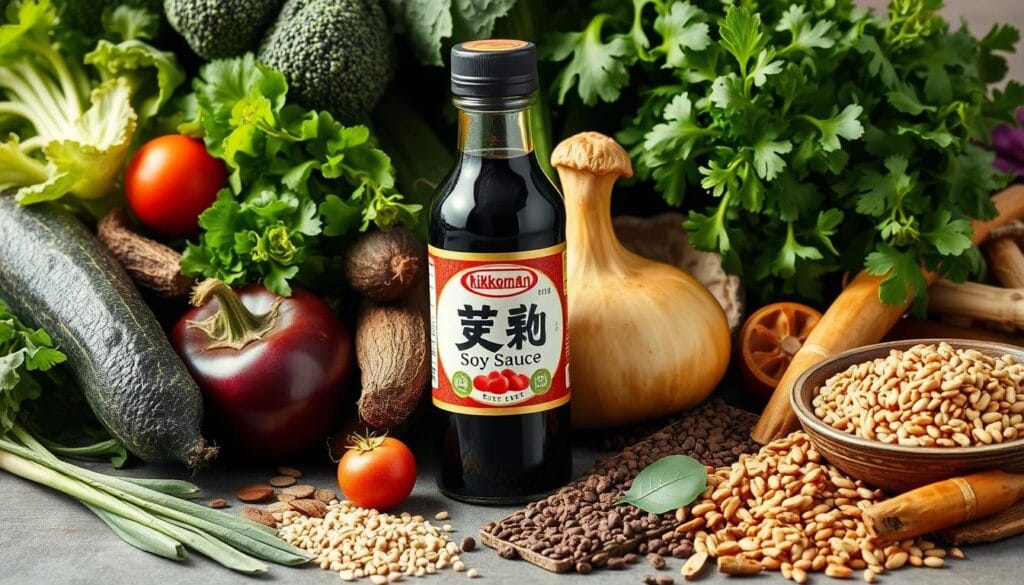
Kikkoman soy sauce also has many health benefits. Its fermentation helps your gut health by creating probiotics. These are key for a healthy gut. Plus, it has amino acids and antioxidants that protect your cells.
Even with less sodium, Kikkoman soy sauce is low in calories, with just 8.5 calories per tablespoon. It’s also almost fat-free. It even has small amounts of iron, manganese, and magnesium, boosting its nutritional value.
Choosing reduced sodium soy sauce doesn’t mean you have to give up flavor. Kikkoman offers a tasty alternative that keeps your dishes delicious and satisfying.
Global Popularity of Kikkoman Soy Sauce
Kikkoman soy sauce is known in over 100 countries. It’s a top choice for soy sauce lovers. Its rich taste and traditional brewing methods have made it a favorite for centuries.
Kikkoman is the biggest soy sauce maker in North America. It offers many types to meet different cooking needs. The company uses only the best ingredients from North America in its soy sauce.
Kikkoman has a wide range of soy sauce options. These include organic, non-GMO, and vegan-friendly choices. With 10 distribution centers in North America, it meets the demand for quality soy sauce. Its traditional brewing process is a big reason why many people prefer Kikkoman.
Kikkoman is also growing its presence globally. In Brazil, it started selling soy sauce in November 2021. It even created a sweet soy sauce for Brazilian tastes. In India, Kikkoman will launch Dark Soy Sauce in February 2024, aiming at the Indian Chinese food market.
Kikkoman’s global growth shows its dedication to quality and taste. It’s a top choice for those who value both taste and authenticity in their cooking.
Kikkoman Soy Sauce in Japanese Cuisine
Kikkoman soy sauce is a key part of Japanese cooking. It’s the top soy sauce brand in Japan, with over 60% of the market. It brings out the flavors in sushi, sashimi, tempura, and more.
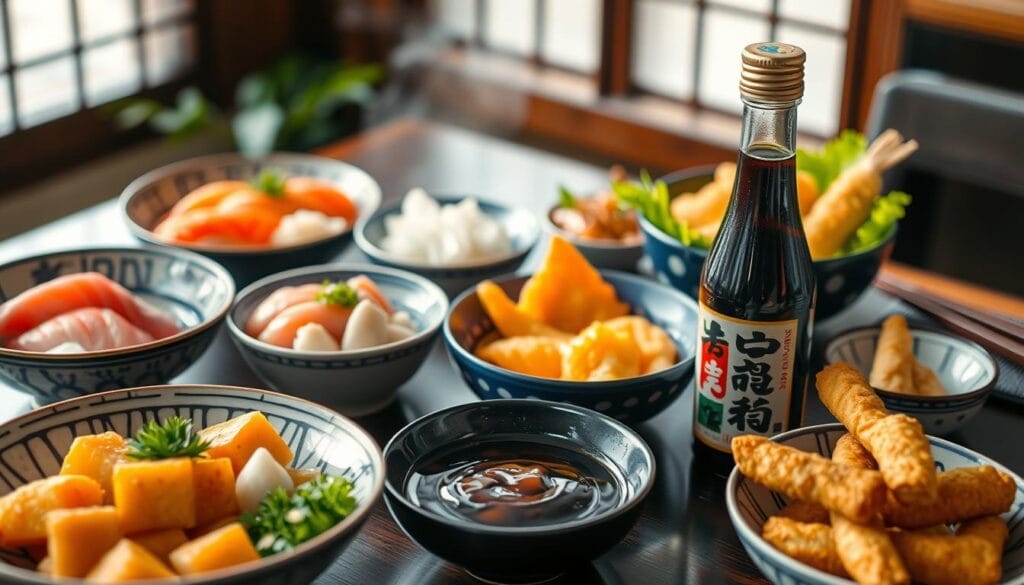
About 70% of Japanese chefs say soy sauce is a must-have. This shows its big role in making both old and new dishes. Kikkoman soy sauce is used in over 100 recipes in Japanese cooking books.
- Sushi: A little Kikkoman soy sauce makes the umami in fresh fish pop, making sushi even better.
- Sashimi: Raw fish slices get a boost from soy sauce, bringing out their natural taste.
- Tempura: Soy sauce adds a savory touch to crispy tempura, making it hard to resist.
People in Japan like soy sauce in different ways. About 45% use light soy sauce for everyday meals. Meanwhile, 30% choose dark soy sauce for its deeper flavor. This shows Kikkoman soy sauce can be used in many ways.
Kikkoman makes a lot of soy sauce, about 257,000 tons a year. It’s a big deal globally, serving both local and international markets. Knowing its importance can make you appreciate Japanese flavors more.
The Impact of Kikkoman on Culinary Traditions Worldwide
Kikkoman soy sauce has changed cooking traditions worldwide since 1957. The first U.S. plant in Walworth, Wisconsin, opened in 1972. This was a big step for soy sauce in American kitchens. The first “Made in the U.S.A.” soy sauce was shipped in 1973.
By 2023, almost half of U.S. homes keep soy sauce on hand. Kikkoman has introduced many soy sauce innovations. The company gave $5 million to the University of Wisconsin for sustainable agriculture and water research. This shows Kikkoman’s commitment to quality and the environment.
Kikkoman works with the Culinary Institute of America to help young chefs. The “Kikkoman Student Innovation Challenge” encourages new flavors. Cristal Torres won a scholarship to learn kaiseki-ryori, a traditional Japanese meal.
Kikkoman soy sauce is used in many dishes worldwide. It makes sauces, dressings, and even desserts better. This has led to new food trends that cross cultural lines. Kikkoman has inspired chefs everywhere, making it a key part of modern cooking.
Conclusion
Kikkoman soy sauce is a top choice in the soy sauce world. It has a real taste and focuses on quality. Its special brewing method makes your food taste better.
Kikkoman uses the best ingredients and a careful fermentation process. This makes the soy sauce not only taste great but also healthier. You can choose from options with less sodium.
Keeping Kikkoman soy sauce in good condition is key. It can stay good at room temperature for six months. But, keeping it in the fridge makes it last even longer.
With Kikkoman, you can make your dishes healthier without losing flavor. It’s a great ingredient for many recipes. It can make your cooking adventures exciting.
Whether you use it on a stir-fry or in salad dressing, Kikkoman soy sauce is versatile. Make it a must-have in your kitchen. It will make your meals more flavorful and enjoyable.

